Global Business in the Asian Century
VerifiedAdded on 2023/01/04
|6
|1353
|82
AI Summary
This document discusses the concept of global strategy, the benefits of expanding globally, and the impact of cost reductions and local responsiveness on strategic choices. It also describes different global strategies for competing in the global marketplace.
Contribute Materials
Your contribution can guide someone’s learning journey. Share your
documents today.
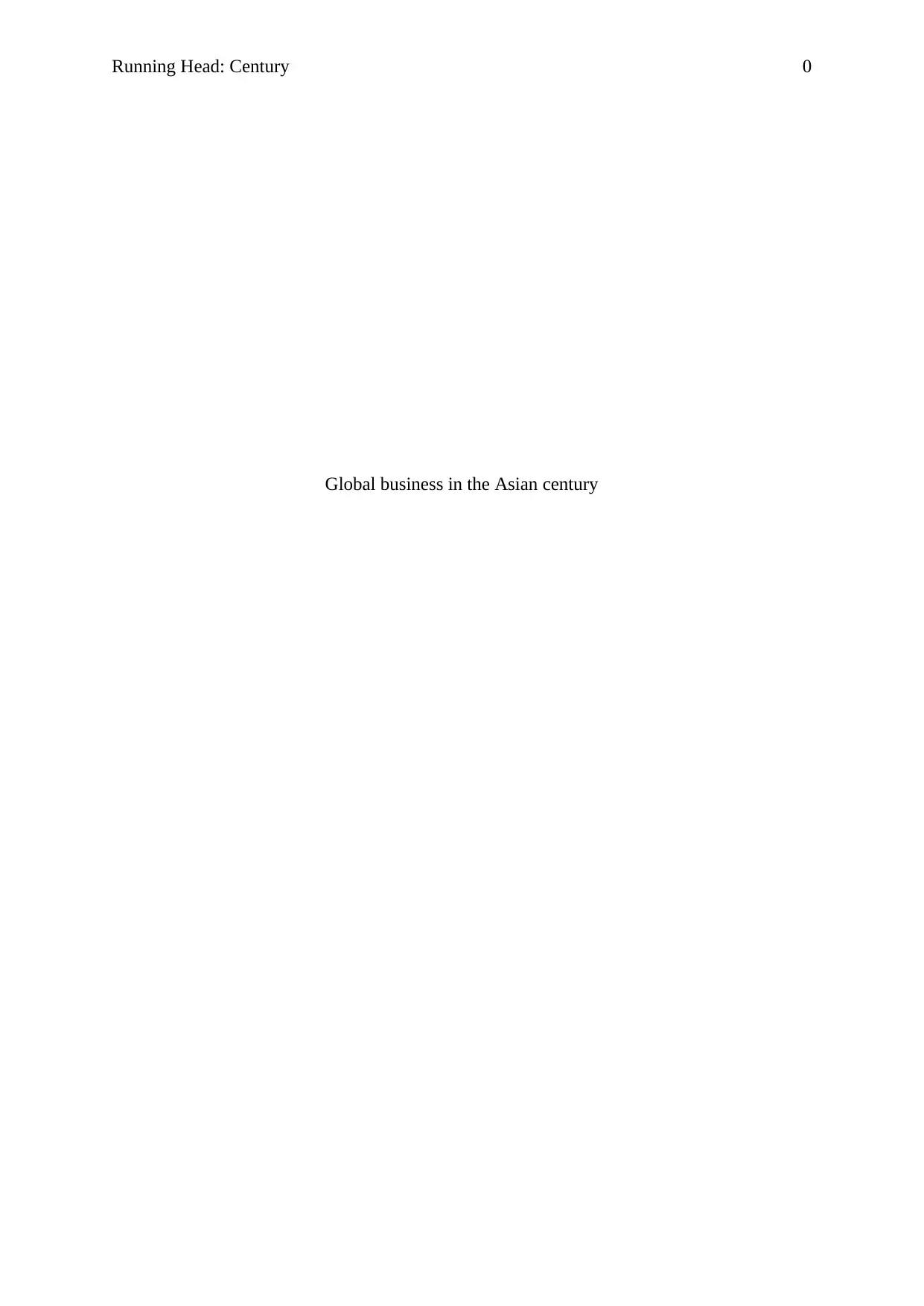
Running Head: Century 0
Global business in the Asian century
Global business in the Asian century
Secure Best Marks with AI Grader
Need help grading? Try our AI Grader for instant feedback on your assignments.
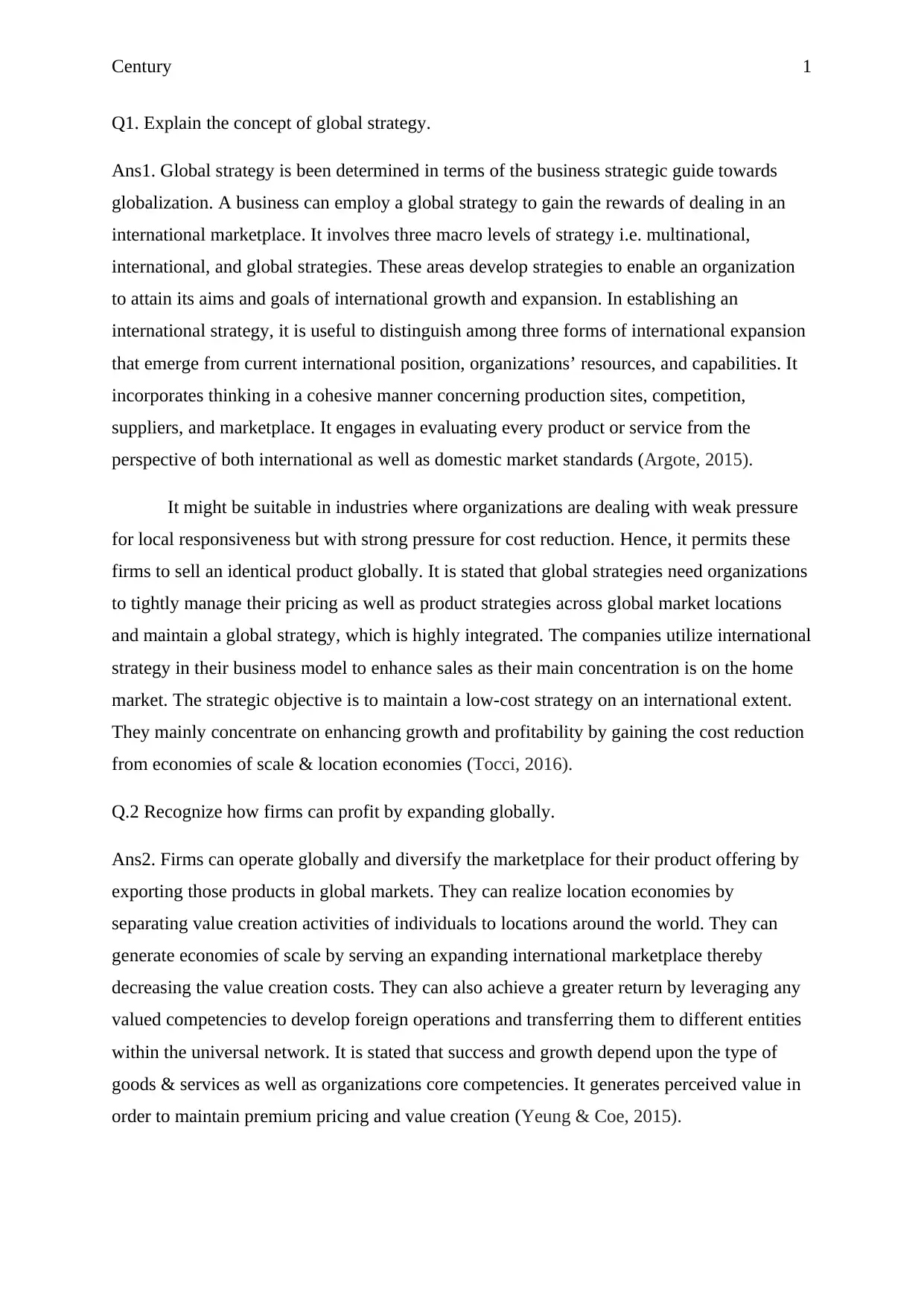
Century 1
Q1. Explain the concept of global strategy.
Ans1. Global strategy is been determined in terms of the business strategic guide towards
globalization. A business can employ a global strategy to gain the rewards of dealing in an
international marketplace. It involves three macro levels of strategy i.e. multinational,
international, and global strategies. These areas develop strategies to enable an organization
to attain its aims and goals of international growth and expansion. In establishing an
international strategy, it is useful to distinguish among three forms of international expansion
that emerge from current international position, organizations’ resources, and capabilities. It
incorporates thinking in a cohesive manner concerning production sites, competition,
suppliers, and marketplace. It engages in evaluating every product or service from the
perspective of both international as well as domestic market standards (Argote, 2015).
It might be suitable in industries where organizations are dealing with weak pressure
for local responsiveness but with strong pressure for cost reduction. Hence, it permits these
firms to sell an identical product globally. It is stated that global strategies need organizations
to tightly manage their pricing as well as product strategies across global market locations
and maintain a global strategy, which is highly integrated. The companies utilize international
strategy in their business model to enhance sales as their main concentration is on the home
market. The strategic objective is to maintain a low-cost strategy on an international extent.
They mainly concentrate on enhancing growth and profitability by gaining the cost reduction
from economies of scale & location economies (Tocci, 2016).
Q.2 Recognize how firms can profit by expanding globally.
Ans2. Firms can operate globally and diversify the marketplace for their product offering by
exporting those products in global markets. They can realize location economies by
separating value creation activities of individuals to locations around the world. They can
generate economies of scale by serving an expanding international marketplace thereby
decreasing the value creation costs. They can also achieve a greater return by leveraging any
valued competencies to develop foreign operations and transferring them to different entities
within the universal network. It is stated that success and growth depend upon the type of
goods & services as well as organizations core competencies. It generates perceived value in
order to maintain premium pricing and value creation (Yeung & Coe, 2015).
Q1. Explain the concept of global strategy.
Ans1. Global strategy is been determined in terms of the business strategic guide towards
globalization. A business can employ a global strategy to gain the rewards of dealing in an
international marketplace. It involves three macro levels of strategy i.e. multinational,
international, and global strategies. These areas develop strategies to enable an organization
to attain its aims and goals of international growth and expansion. In establishing an
international strategy, it is useful to distinguish among three forms of international expansion
that emerge from current international position, organizations’ resources, and capabilities. It
incorporates thinking in a cohesive manner concerning production sites, competition,
suppliers, and marketplace. It engages in evaluating every product or service from the
perspective of both international as well as domestic market standards (Argote, 2015).
It might be suitable in industries where organizations are dealing with weak pressure
for local responsiveness but with strong pressure for cost reduction. Hence, it permits these
firms to sell an identical product globally. It is stated that global strategies need organizations
to tightly manage their pricing as well as product strategies across global market locations
and maintain a global strategy, which is highly integrated. The companies utilize international
strategy in their business model to enhance sales as their main concentration is on the home
market. The strategic objective is to maintain a low-cost strategy on an international extent.
They mainly concentrate on enhancing growth and profitability by gaining the cost reduction
from economies of scale & location economies (Tocci, 2016).
Q.2 Recognize how firms can profit by expanding globally.
Ans2. Firms can operate globally and diversify the marketplace for their product offering by
exporting those products in global markets. They can realize location economies by
separating value creation activities of individuals to locations around the world. They can
generate economies of scale by serving an expanding international marketplace thereby
decreasing the value creation costs. They can also achieve a greater return by leveraging any
valued competencies to develop foreign operations and transferring them to different entities
within the universal network. It is stated that success and growth depend upon the type of
goods & services as well as organizations core competencies. It generates perceived value in
order to maintain premium pricing and value creation (Yeung & Coe, 2015).
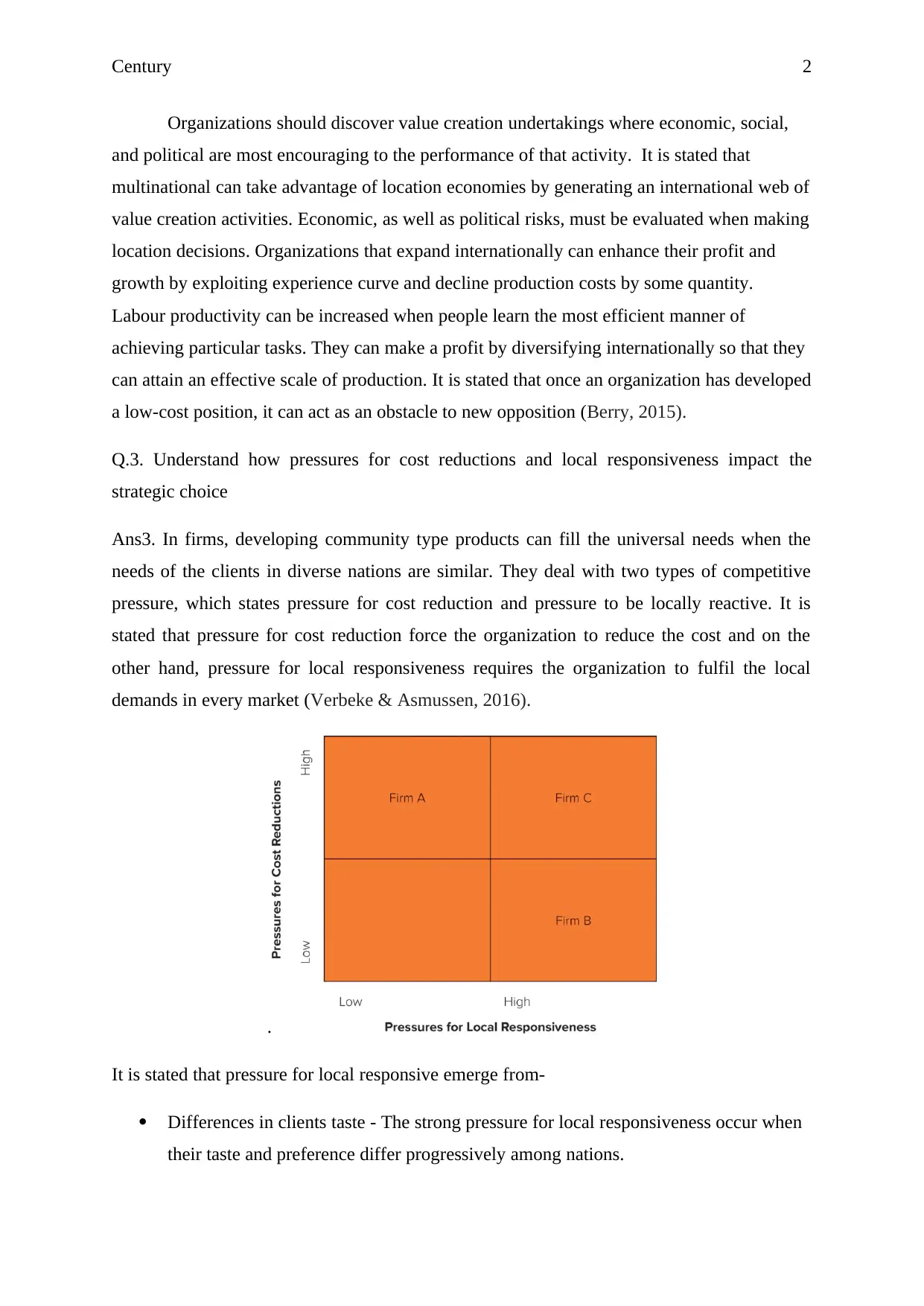
Century 2
Organizations should discover value creation undertakings where economic, social,
and political are most encouraging to the performance of that activity. It is stated that
multinational can take advantage of location economies by generating an international web of
value creation activities. Economic, as well as political risks, must be evaluated when making
location decisions. Organizations that expand internationally can enhance their profit and
growth by exploiting experience curve and decline production costs by some quantity.
Labour productivity can be increased when people learn the most efficient manner of
achieving particular tasks. They can make a profit by diversifying internationally so that they
can attain an effective scale of production. It is stated that once an organization has developed
a low-cost position, it can act as an obstacle to new opposition (Berry, 2015).
Q.3. Understand how pressures for cost reductions and local responsiveness impact the
strategic choice
Ans3. In firms, developing community type products can fill the universal needs when the
needs of the clients in diverse nations are similar. They deal with two types of competitive
pressure, which states pressure for cost reduction and pressure to be locally reactive. It is
stated that pressure for cost reduction force the organization to reduce the cost and on the
other hand, pressure for local responsiveness requires the organization to fulfil the local
demands in every market (Verbeke & Asmussen, 2016).
.
It is stated that pressure for local responsive emerge from-
Differences in clients taste - The strong pressure for local responsiveness occur when
their taste and preference differ progressively among nations.
Organizations should discover value creation undertakings where economic, social,
and political are most encouraging to the performance of that activity. It is stated that
multinational can take advantage of location economies by generating an international web of
value creation activities. Economic, as well as political risks, must be evaluated when making
location decisions. Organizations that expand internationally can enhance their profit and
growth by exploiting experience curve and decline production costs by some quantity.
Labour productivity can be increased when people learn the most efficient manner of
achieving particular tasks. They can make a profit by diversifying internationally so that they
can attain an effective scale of production. It is stated that once an organization has developed
a low-cost position, it can act as an obstacle to new opposition (Berry, 2015).
Q.3. Understand how pressures for cost reductions and local responsiveness impact the
strategic choice
Ans3. In firms, developing community type products can fill the universal needs when the
needs of the clients in diverse nations are similar. They deal with two types of competitive
pressure, which states pressure for cost reduction and pressure to be locally reactive. It is
stated that pressure for cost reduction force the organization to reduce the cost and on the
other hand, pressure for local responsiveness requires the organization to fulfil the local
demands in every market (Verbeke & Asmussen, 2016).
.
It is stated that pressure for local responsive emerge from-
Differences in clients taste - The strong pressure for local responsiveness occur when
their taste and preference differ progressively among nations.
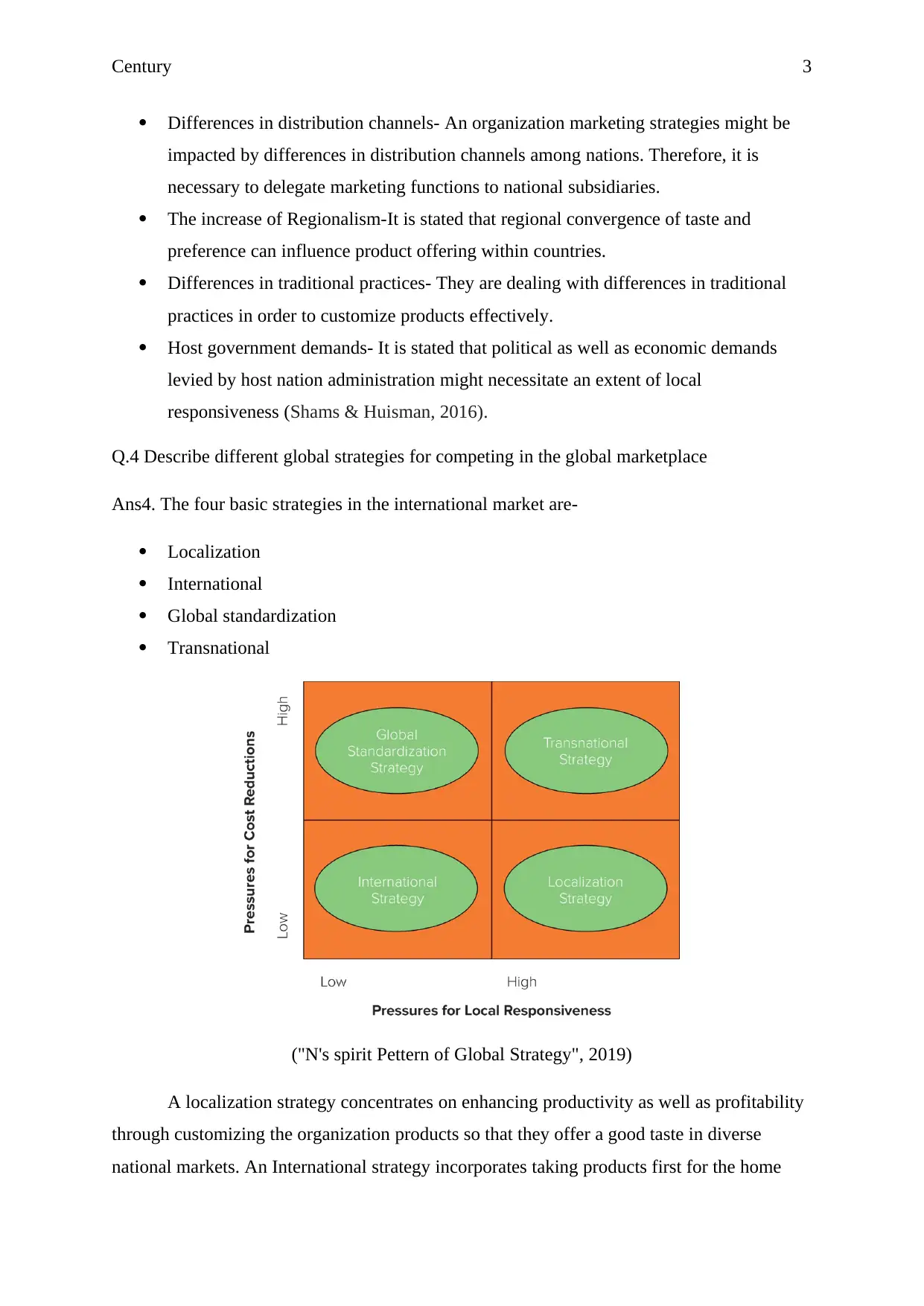
Century 3
Differences in distribution channels- An organization marketing strategies might be
impacted by differences in distribution channels among nations. Therefore, it is
necessary to delegate marketing functions to national subsidiaries.
The increase of Regionalism-It is stated that regional convergence of taste and
preference can influence product offering within countries.
Differences in traditional practices- They are dealing with differences in traditional
practices in order to customize products effectively.
Host government demands- It is stated that political as well as economic demands
levied by host nation administration might necessitate an extent of local
responsiveness (Shams & Huisman, 2016).
Q.4 Describe different global strategies for competing in the global marketplace
Ans4. The four basic strategies in the international market are-
Localization
International
Global standardization
Transnational
("N's spirit Pettern of Global Strategy", 2019)
A localization strategy concentrates on enhancing productivity as well as profitability
through customizing the organization products so that they offer a good taste in diverse
national markets. An International strategy incorporates taking products first for the home
Differences in distribution channels- An organization marketing strategies might be
impacted by differences in distribution channels among nations. Therefore, it is
necessary to delegate marketing functions to national subsidiaries.
The increase of Regionalism-It is stated that regional convergence of taste and
preference can influence product offering within countries.
Differences in traditional practices- They are dealing with differences in traditional
practices in order to customize products effectively.
Host government demands- It is stated that political as well as economic demands
levied by host nation administration might necessitate an extent of local
responsiveness (Shams & Huisman, 2016).
Q.4 Describe different global strategies for competing in the global marketplace
Ans4. The four basic strategies in the international market are-
Localization
International
Global standardization
Transnational
("N's spirit Pettern of Global Strategy", 2019)
A localization strategy concentrates on enhancing productivity as well as profitability
through customizing the organization products so that they offer a good taste in diverse
national markets. An International strategy incorporates taking products first for the home
Paraphrase This Document
Need a fresh take? Get an instant paraphrase of this document with our AI Paraphraser

Century 4
market and retailing them globally with local customization. A global standardization
concentrates on enhancing growth and profitability by acquiring the cost reductions that
emerge from economies of scale and learning effects. It is stated that their main goal is to
maintain a low-cost strategy on an international scale. A transnational strategy takes effort to
maintain a multidirectional flow of competencies among diverse subsidiaries. It also
differentiates the product offering through geographic extents to local differences (De Mooij,
2018).
It is stated that as competition becomes more intense, localization, as well as
international strategy, is less feasible. To survive, organizations need to shift towards
transnational or global standardization strategy in order to contend with competitors.
Localization provides organizations a competitive advantage but if the organization is dealing
with aggressive competition, they have to decrease its cost structure and shift towards a
transnational strategy (Yeung, 2016).
market and retailing them globally with local customization. A global standardization
concentrates on enhancing growth and profitability by acquiring the cost reductions that
emerge from economies of scale and learning effects. It is stated that their main goal is to
maintain a low-cost strategy on an international scale. A transnational strategy takes effort to
maintain a multidirectional flow of competencies among diverse subsidiaries. It also
differentiates the product offering through geographic extents to local differences (De Mooij,
2018).
It is stated that as competition becomes more intense, localization, as well as
international strategy, is less feasible. To survive, organizations need to shift towards
transnational or global standardization strategy in order to contend with competitors.
Localization provides organizations a competitive advantage but if the organization is dealing
with aggressive competition, they have to decrease its cost structure and shift towards a
transnational strategy (Yeung, 2016).
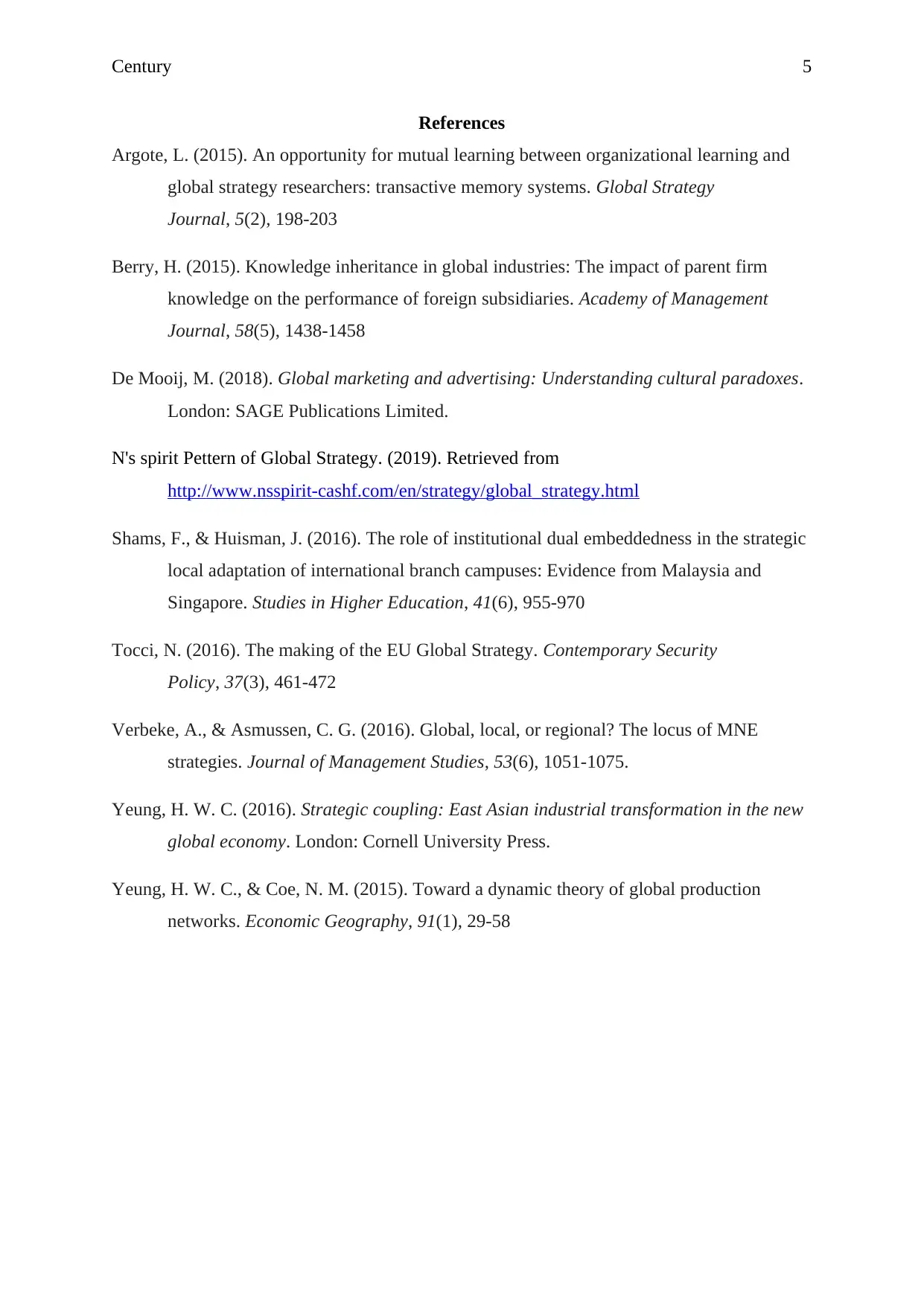
Century 5
References
Argote, L. (2015). An opportunity for mutual learning between organizational learning and
global strategy researchers: transactive memory systems. Global Strategy
Journal, 5(2), 198-203
Berry, H. (2015). Knowledge inheritance in global industries: The impact of parent firm
knowledge on the performance of foreign subsidiaries. Academy of Management
Journal, 58(5), 1438-1458
De Mooij, M. (2018). Global marketing and advertising: Understanding cultural paradoxes.
London: SAGE Publications Limited.
N's spirit Pettern of Global Strategy. (2019). Retrieved from
http://www.nsspirit-cashf.com/en/strategy/global_strategy.html
Shams, F., & Huisman, J. (2016). The role of institutional dual embeddedness in the strategic
local adaptation of international branch campuses: Evidence from Malaysia and
Singapore. Studies in Higher Education, 41(6), 955-970
Tocci, N. (2016). The making of the EU Global Strategy. Contemporary Security
Policy, 37(3), 461-472
Verbeke, A., & Asmussen, C. G. (2016). Global, local, or regional? The locus of MNE
strategies. Journal of Management Studies, 53(6), 1051-1075.
Yeung, H. W. C. (2016). Strategic coupling: East Asian industrial transformation in the new
global economy. London: Cornell University Press.
Yeung, H. W. C., & Coe, N. M. (2015). Toward a dynamic theory of global production
networks. Economic Geography, 91(1), 29-58
References
Argote, L. (2015). An opportunity for mutual learning between organizational learning and
global strategy researchers: transactive memory systems. Global Strategy
Journal, 5(2), 198-203
Berry, H. (2015). Knowledge inheritance in global industries: The impact of parent firm
knowledge on the performance of foreign subsidiaries. Academy of Management
Journal, 58(5), 1438-1458
De Mooij, M. (2018). Global marketing and advertising: Understanding cultural paradoxes.
London: SAGE Publications Limited.
N's spirit Pettern of Global Strategy. (2019). Retrieved from
http://www.nsspirit-cashf.com/en/strategy/global_strategy.html
Shams, F., & Huisman, J. (2016). The role of institutional dual embeddedness in the strategic
local adaptation of international branch campuses: Evidence from Malaysia and
Singapore. Studies in Higher Education, 41(6), 955-970
Tocci, N. (2016). The making of the EU Global Strategy. Contemporary Security
Policy, 37(3), 461-472
Verbeke, A., & Asmussen, C. G. (2016). Global, local, or regional? The locus of MNE
strategies. Journal of Management Studies, 53(6), 1051-1075.
Yeung, H. W. C. (2016). Strategic coupling: East Asian industrial transformation in the new
global economy. London: Cornell University Press.
Yeung, H. W. C., & Coe, N. M. (2015). Toward a dynamic theory of global production
networks. Economic Geography, 91(1), 29-58
1 out of 6
![[object Object]](/_next/static/media/star-bottom.7253800d.svg)





